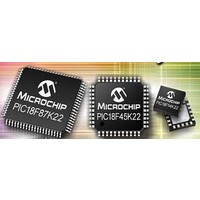PIC18F46K22-I/MV Microchip Technology, PIC18F46K22-I/MV Datasheet - Page 266

PIC18F46K22-I/MV
Manufacturer Part Number
PIC18F46K22-I/MV
Description
64KB, Flash, 3968bytes-RAM,8-bit Family,nanoWatt XLP 40 UQFN 5x5x0.5mm TUBE
Manufacturer
Microchip Technology
Series
PIC® XLP™ 18Fr
Datasheet
1.PIC18F26J13-ISS.pdf
(496 pages)
Specifications of PIC18F46K22-I/MV
Core Processor
PIC
Core Size
8-Bit
Speed
64MHz
Connectivity
I²C, SPI, UART/USART
Peripherals
Brown-out Detect/Reset, HLVD, POR, PWM, WDT
Number Of I /o
35
Program Memory Size
64KB (32K x 16)
Program Memory Type
FLASH
Eeprom Size
1K x 8
Ram Size
3.8K x 8
Voltage - Supply (vcc/vdd)
1.8 V ~ 5.5 V
Data Converters
A/D 30x10b
Oscillator Type
Internal
Operating Temperature
-40°C ~ 85°C
Package / Case
40-UFQFN Exposed Pad
Processor Series
PIC18F
Core
PIC
Data Bus Width
8 bit
Data Ram Size
4 KB
Number Of Programmable I/os
36
Number Of Timers
3 x 8-bit. 4 x 16-bit
Operating Supply Voltage
1.8 V to 5.5 V
Mounting Style
SMD/SMT
Lead Free Status / RoHS Status
Lead free / RoHS Compliant
Lead Free Status / RoHS Status
Lead free / RoHS Compliant
- Current page: 266 of 496
- Download datasheet (5Mb)
PIC18(L)F2X/4XK22
16.1.1.5
The TRMT bit of the TXSTAx register indicates the
status of the TSR register. This is a read-only bit. The
TRMT bit is set when the TSR register is empty and is
cleared when a character is transferred to the TSR
register from the TXREGx. The TRMT bit remains clear
until all bits have been shifted out of the TSR register.
No interrupt logic is tied to this bit, so the user needs to
poll this bit to determine the TSR status.
16.1.1.6
The EUSART supports 9-bit character transmissions.
When the TX9 bit of the TXSTAx register is set the
EUSART will shift 9 bits out for each character transmit-
ted. The TX9D bit of the TXSTAx register is the ninth,
and Most Significant, data bit. When transmitting 9-bit
data, the TX9D data bit must be written before writing
the 8 Least Significant bits into the TXREGx. All nine
bits of data will be transferred to the TSR shift register
immediately after the TXREGx is written.
A special 9-bit Address mode is available for use with
multiple receivers. See
Detection”
FIGURE 16-3:
DS41412D-page 266
Note:
Reg. Empty Flag)
Reg. Empty Flag)
Write to TXREGx
(Transmit Buffer
(Transmit Shift
TXx/CKx
BRG Output
(Shift Clock)
TRMT bit
TXxIF bit
The TSR register is not mapped in data
memory, so it is not available to the user.
for more information on the Address mode.
TSR Status
Transmitting 9-Bit Characters
pin
ASYNCHRONOUS TRANSMISSION
Word 1
Transmit Shift Reg
Word 1
Section 16.1.2.8 “Address
1 T
CY
Start bit
bit 0
Preliminary
bit 1
Word 1
16.1.1.7
1.
2.
3.
4.
5.
6.
7.
8.
9.
Initialize the SPBRGHx:SPBRGx register pair
and the BRGH and BRG16 bits to achieve the
desired baud rate (see
Baud Rate Generator
Set the RXx/DTx and TXx/CKx TRIS controls to
‘1’.
Enable the asynchronous serial port by clearing
the SYNC bit and setting the SPEN bit.
If 9-bit transmission is desired, set the TX9 con-
trol bit. A set ninth data bit will indicate that the 8
Least Significant data bits are an address when
the receiver is set for address detection.
Set the CKTXP control bit if inverted transmit
data polarity is desired.
Enable the transmission by setting the TXEN
control bit. This will cause the TXxIF interrupt bit
to be set.
If interrupts are desired, set the TXxIE interrupt
enable bit. An interrupt will occur immediately
provided that the GIE/GIEH and PEIE/GIEL bits
of the INTCON register are also set.
If 9-bit transmission is selected, the ninth bit
should be loaded into the TX9D data bit.
Load 8-bit data into the TXREGx register. This
will start the transmission.
Asynchronous Transmission Setup:
bit 7/8
2010 Microchip Technology Inc.
(BRG)”).
Stop bit
Section 16.3 “EUSART
Related parts for PIC18F46K22-I/MV
Image
Part Number
Description
Manufacturer
Datasheet
Request
R

Part Number:
Description:
Manufacturer:
Microchip Technology Inc.
Datasheet:

Part Number:
Description:
Manufacturer:
Microchip Technology Inc.
Datasheet:

Part Number:
Description:
Manufacturer:
Microchip Technology Inc.
Datasheet:

Part Number:
Description:
Manufacturer:
Microchip Technology Inc.
Datasheet:

Part Number:
Description:
Manufacturer:
Microchip Technology Inc.
Datasheet:

Part Number:
Description:
Manufacturer:
Microchip Technology Inc.
Datasheet:

Part Number:
Description:
Manufacturer:
Microchip Technology Inc.
Datasheet:

Part Number:
Description:
Manufacturer:
Microchip Technology Inc.
Datasheet:










